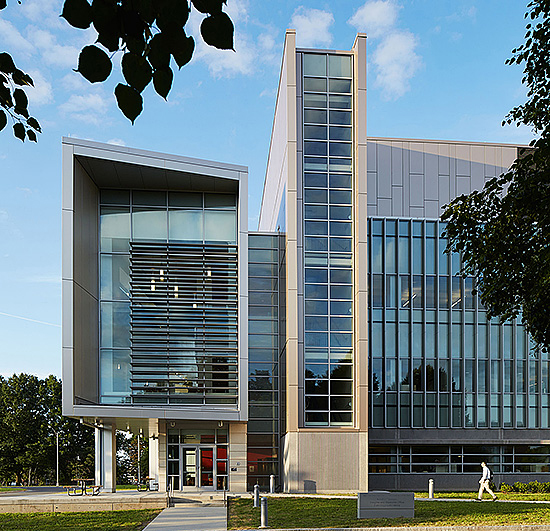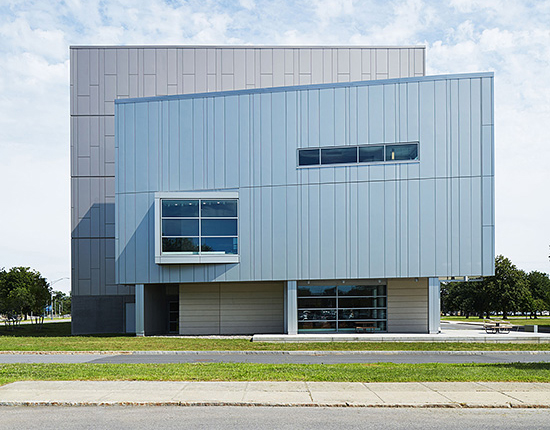Medal-Winning Metal
The Raid on Rainscreens
Another popular metal-based building enclosure solution is rainscreens. Unlike insulated metal panels these systems incorporate an air space in between the metal panels and membrane, offering architects more design flexibility.
The metal panel is the first line of defense against moisture and wind pressure. Next, the air space, also known as the drainage plane, supports moisture drainage and serves as a pressure equalizer. The insulation is located behind the drainage plane, outside the wall structure, effectively moving the dew point to the exterior, which reduces the possibility of condensation inside the wall and the potential for thermal bridging.
Although more expensive than IMPs, rainscreens offer enhanced moisture and thermal performance.
“We’ve used open joint pressure-equalized metal panel rainscreen systems for a number of years,” relates Boley. “I like the simplicity of detailing, the strength of the system’s ability to shed and control water and the thermal qualities inherent in a highly insulated skin system. The beauty of the system is that the water protection membrane detailing and installation is quite simple and clean, while the metal panel cloak that hides it can be complex or very textured due to the flexibility of profiles and colors.”
Also called ventilated rainscreens, these systems – which don’t rely on sealants – are known for protecting buildings from adverse weather conditions including positive and negative wind loads, seismic and thermal movement.
“When installed with a vapor barrier on the outside face of the backup wall to act as a final air and water barrier, the system is very effective,” explains Peter Carideo, RA, LEED AP, director of architecture, HDR, New York. “With the insulation installed outside the air and vapor barrier, condensation continually evaporates because of the air movement, resulting in a 50 percent higher insulation value and reduced energy consumption.”
Of course, rainscreen design is not without its challenges. In particular, it can be tricky to compartmentalize the air flow or design the screen in cells in order to keep the air pressure from sucking water into the membrane, cautions Carideo. Detailing the transitions from the rainscreen to other barrier systems – i.e., glazing or masonry – so that the rainscreen maintains its performance integrity and seamless aesthetic is yet another challenge.
Sometimes, to make a project more cost effective or achieve a certain look, HDR will go with a hybrid façade, putting IMPs in less visible locations, while the rainscreen is reserved for the façade’s more prominent areas such as the entrance. Still, careful detailing is essential to support a properly performing system.
For example, HDR specified a hybrid rain-screen and standard insulated metal system at the New York State Food, Safety and Metrology Laboratory in Albany, N.Y. In addition, perforated metal panels were used for sun shading on the east facade.


Photo courtesy of HDR
For the New York State Food, Safety and Metrology Laboratory, Albany, N.Y., HDR went with a hybrid rain-screen and standard insulated metal system for a cost effective, high-performance enclosure.









